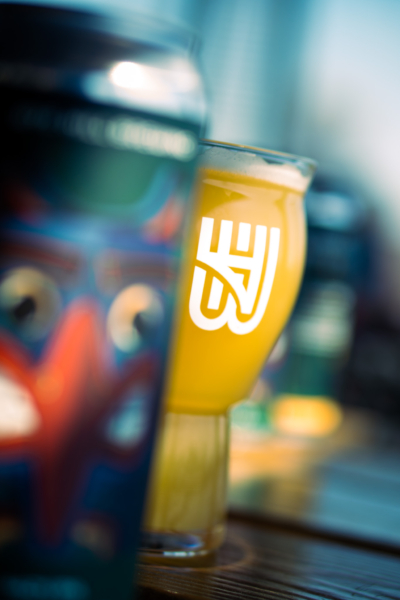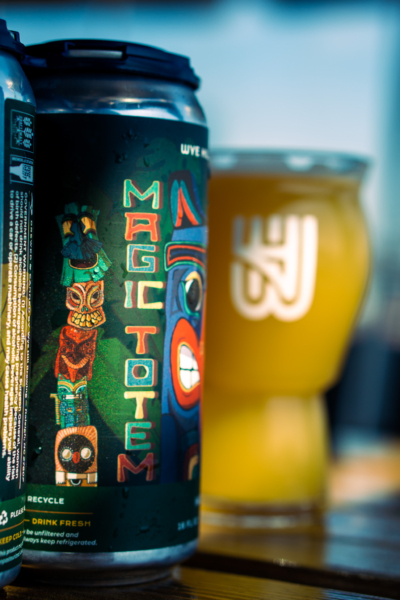EMBLEMATIC AND REFERENTIAL, THIS HAZY IPA IS A PILLAR OF TROPICAL FLAVORS
The craft beer scene is expansive in almost every sense of the word. It is seemingly limitless in geographical reach and stylistic experimentation. Despite how fully-formed it may seem, the industry is still quite new. The scene originated in the 1960s, with a substantial boom occurring in the ‘90s and ‘00s.
So, when modernity is referenced within the craft beer movement, it denotes only a teeny-tiny window of time.
At this particular moment on the timeline, the buzzword in the way of IPAs is haze.
LOST IN A…
V ery fruity flavors reign supreme in the modern craft beer world. These fruit-forward qualities are closely correlated with ‘hazy’ beers. In terms of appearance, the haze comes from hop oils during dry hopping. Proteins and polyphenols (aromatic chemicals) in the grain combine to form a colloidal haze, which is opaque or cloudy.
ery fruity flavors reign supreme in the modern craft beer world. These fruit-forward qualities are closely correlated with ‘hazy’ beers. In terms of appearance, the haze comes from hop oils during dry hopping. Proteins and polyphenols (aromatic chemicals) in the grain combine to form a colloidal haze, which is opaque or cloudy.
Arguably the first and most illustrious example of the style was Heady Topper, a New England IPA by The Alchemist in Vermont. There was a great deal of mythology surrounding Heady Topper, and how exactly the brewers got it to look so… well… hazy. The secret seemed to be mastering stable haze. Protein molecules need to be big enough to be seen, but not too big, so as to drop out of a solution and make the beer clear again. Heady Topper became the blueprint for many many hazy IPAs to follow.
The yeast strain used by The Alchemist, London Ale III, served as the model for Cosmic Punch, the genetically modified version of the strain that the brewers at Wye have used quite a few times in thiolation. The same is true for their most current venture into haze heaven– Magic Totem, a thiolized hazy IPA.
They’ve continuously used Cosmic Punch in our beloved, award-winning thiolized hazy pale ale, Luminous Beings. According to Greg Winget, Director of Brewing Operations, the production timeline works in a way where the brewers can reuse yeast. Cones at the bottom of the tanks recollect yeast, then re-pitch it into another tank and use it to ferment multiple times afterwards.
“We started making Luminous Beings to make IPAs with Cosmic Punch, and it became such a hit that we kept making it all the time,” Greg said. “It just fits into our production schedule very well, because we’re always making hazy IPAs, and we’re always making Luminous Beings, so it just goes from one to the next.”
TOP OF THE TOTEM POLE
 Magic Totem was given a very cool face, thanks to visual artist (and woman of many artistic trades) Sadie Tynch. Sadie designed the can art for the IPA, as she has for several of our beers, including Luminous Beings. The main totem on the can-wrap represents the Pacific Northwest/American Indian influence. Maori and South Pacific Islander totems were also included. This is a nod to the hops used in the brewing process, brought to life beautifully by Sadie.
Magic Totem was given a very cool face, thanks to visual artist (and woman of many artistic trades) Sadie Tynch. Sadie designed the can art for the IPA, as she has for several of our beers, including Luminous Beings. The main totem on the can-wrap represents the Pacific Northwest/American Indian influence. Maori and South Pacific Islander totems were also included. This is a nod to the hops used in the brewing process, brought to life beautifully by Sadie.
Taiheke and Wakatu are both New Zealand hops, and Azacca is a Pacific Northwest hop.
“It’s kinda like taking that locational, native culture and doing a mashup,” Greg said.
Taiheke is New Zealand’s Cascade hop– Cascade being the hop that put hops on the map in North America. It is named differently because its flavors are not quite similar to Cascade’s.
“It’s a really good example of terroir in beer ingredients, because basically, they’re growing a hop that was developed and traditionally grown in the Pacific Northwest of the U.S., and they’re growing it on the entirely opposite side of the world,” Greg said. “So, it tastes completely different.”
Working alongside Taiheke in Magic Totem, Wakatu lends flavors of lime zest, while Azacca is extremely tropical tasting, especially for an American hop.
A sturdy pylon of hops and haze.


